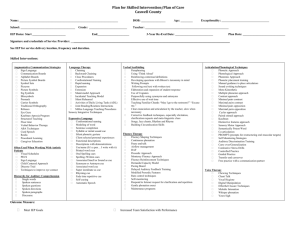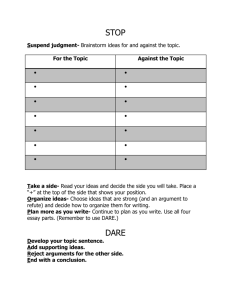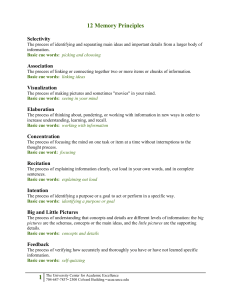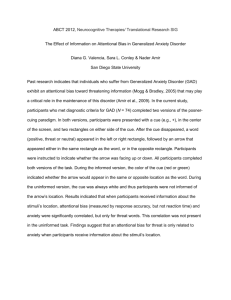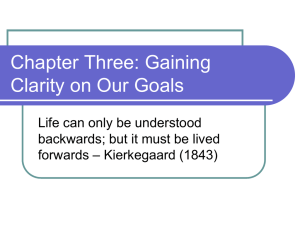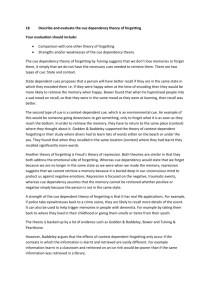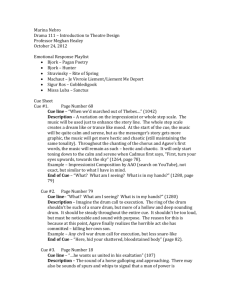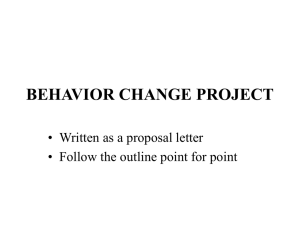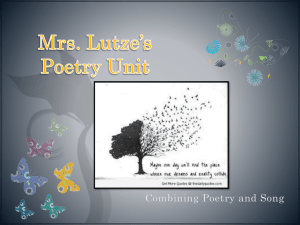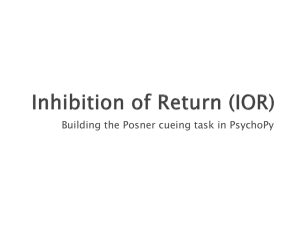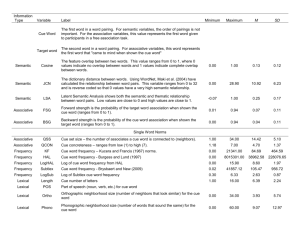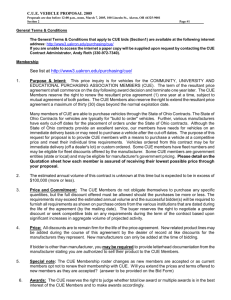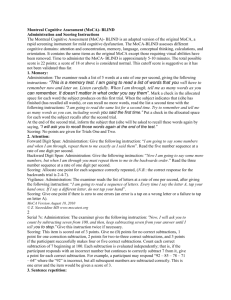games-for-learning-send-out-june-2011
advertisement
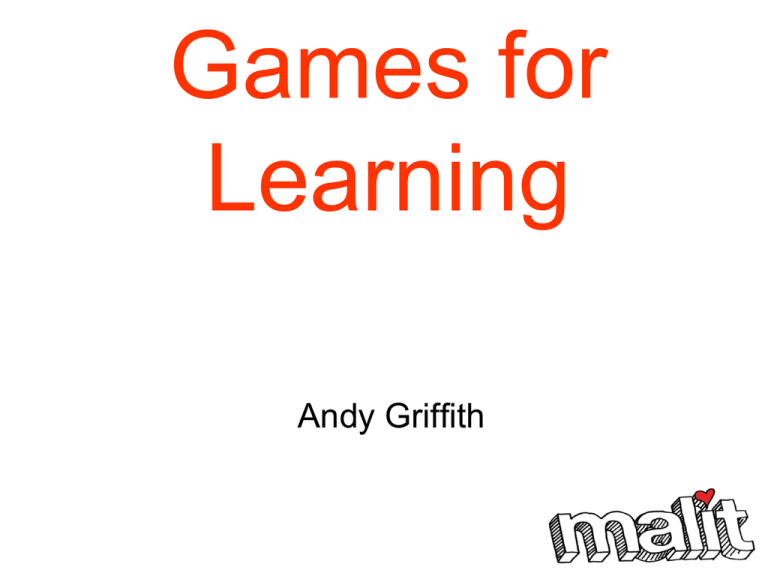
Games for Learning Andy Griffith Outline for the session Can we explore: 1. The importance of play in learning? 2. Different types of games? 3. Managing students before, during and after games? 4. Unpicking the learning from games? 5. Build your confidence in the using, adapting and devising games? Emotionally mature people are: AUTHENTIC VIVACIOUS PLAYFUL Affluenza by Oliver James Playing games All games gave a distinct STRUCTURE and RULES Speed Dating Hopes Analysis Games for different personalities! Personality Types Types of Games Creative thinking games Problem-solving games Strategy Games Mystery games Decision making games Communication games Energising games Story games Question games Concentration games Language games Number games Memory games Known to the Unknown First start off with something they know and can make a positive association with. Facts in Five FOOD M A L I T DRINK BOOK SINGER MEN Using Bloom’s Taxonomy EVALUATION Making judgements. Assessing the value of something against a set of criteria (Judge, Recommend, Evaluate, Prioritise, Give opinions) SYNTHESIS Using old ideas to create something new. Relate knowledge from different sources (Design, Compose, Create, Hypothesise, Rearrange) ANALYSIS Seeing patterns, Understanding how parts relate to the whole. Recognising structure (Investigate, Classify, Compare, Contrast) APPLICATION Using knowledge to solve problems (Make, Build, Demonstrate, Map, Draw) COMPREHENSION Understanding information. Grasping meaning (Give examples, Explain, Show) KNOWLEDGE Observing and recalling information. (Tell,Recite, Make a list, What …?) Facts in Five ? ? ? ? ? ? ? ? ? ? Known to the Unknown First: start off with something they know and can make a positive association with. Then: teacher applies this to a topic. Then: student applies. Tarsia andy@malit.org.uk www.malit.org.uk Free Stuff! ENTRY (Thinking) GAMES ODD ONE OUT WORDLES/DINGBATS THINKING ABCs MORAL DILEMMAS a=3 b=2 c=5 d = 10 e=4 baa a+b+c+d +e 1000 cd b+e+d ad - 12 ce d e²+b² - a² b+a+b+e 6e + 7d (abc)+ d² cab 8c – 8a ba+ba b+e+ad b²+c² 3de c be – b 12a + 5c bead e + b² 3c³ abc² (da)² abc – d 3d bee (da)² + da² bed bad de+da dee deb d² caca 7e + 7c ccd d+eb² 2a + 3b + 4c ab+ba (abc)² ce + da b+a+d 8d - a² 5bc d²+5c 9b² 5d b da² a³ Take turns to pick a square and calculate the value of the expression. Try to be the first player to connect four in a row. Then try to be the player with the most squares! Total catch Living Graphs Overfishing Time Can’t Play; Won’t Play Who won’t play and why? Motivational Styles/Deficits Learned Helplessness (Seligman, 1975) High self-worth concern and the threatened sense of self (Covington, 1984): “What’s the point? I’m going to fail ANYWAY.” “I’m not doing this, it’s rubbish” Students do not persist or take chances. Fear being seen as incompetent. When they fail they Personalise it, think it will be Pervasive, and think it will be Permanent. Prefer to be seen as rude and abusive rather than having their ability called into question. Games for Ideas “If at first, the idea is not absurd, then there is no hope for it.” Albert Einstein Some Ground rules, maybe? • “We encourage everyone to contribute ideas.” • “We give reasons for our ideas and opinions.” • “We can disagree with others but we treat other people’s ideas with respect.” • “We are prepared to change our minds but we don’t have to.” • “We work with our group members and teachers to learn.” Contracts • Group and Individual • Example: ABCDEF Ask Questions Be Open Communicate Do Your best Enjoy yourself (and let others enjoy themselves) Freeze on command! Sign _______________ Motivational Triggers (why people want to learn) • • • • • Choice Challenge Curiosity Competency Positive expectations • • • • • Fun Fantasy Relationships Relevance Fear/Thrill Playing Games First: CONTAIN Then: ENTERTAIN Then: EXPLAIN Ian Gilbert – Essential Motivation Creating the playful classroom Group Norms for your classroom/learning area? 1 2 3 USA 4 UK PIMP YOUR LESSON Before After 3 Minute Motivators - Steps: 1. 2. 3. 4. 5. 6. 7. 8. Cue to gain attention. Explain why motivator being used. Explain the activity. Remind students to begin and freeze on cue. Cue to begin. Present the 3 Minute Motivator. Cue to Stop. Conclude and refocus by summarising what was done and why. Step 2 Explain why the motivator is being used: “I have lost you…” “You seem restless…” “I can see you need a break…” “You seem to need some talk time…” Step 8 Conclude and refocus by summarising what was done and why: “We were all a bit restless so we just played _______. Now that you’ve used up a bit of energy its time to return to…” “You seemed sleepy and many of you were losing attention so we played _______. Now that you’re awake…” “I felt we needed a quick break so we played _______. Okay now back to …” 3 Minute Motivators - examples • • • • • • • • • • Questions only Physical ‘jerks’ Personal Best Verbal Tennis Shared pen and Double pen games Box me in! Karate time Story Games Get Shirty Chinese Whispers • • • • • • • • • • • Silent Maths Syllables Charade Challenge X-Factor Beat the Teacher Speed Dating Back to back, Walk-Stop Continuum Rapidough Unusual images Imagine If… Mystery Games CONSENSUS on “Generation Y” ‘Boomers’ ‘Idealist’ ‘Civic’ Gen. X 1943 – 63 1964 – 81 Gen. Y ‘Millennials’ 1982 – 2001 2001 – 2022? ‘Reactive’ ‘Adaptive’ Howe & Strauss, 1991 Encouraging Deeper Thinking • POINT = 1 point • BECAUSE = 2 points • THEREFORE = 3 points • HOWEVER = 4 points Be able to answer a Question well More wisdom than professors! “It ain’t what you do; it’s the way that you do it – that’s what gets results.” Bananarama



